Jan 25, 2011-2011
Egypt
Protest at Tahrir Square
Share
ACTIVISTS/ACT.GROUPS/DESCRIPTION OF THE GROUP
Youth activists, Kefaya, Democratic Front Party, National Association for Change, Muslim Brotherhood, labor groups, nationalists
TARGET
Hosni Mubarak and his government
WIDELY HELD BELIEF
Corrupt governments should resign. Democracy should be established.
CASE NARRATIVE
Issue and Opponent: In 2011, President Hosni Mubarak had been the head of state in Egypt for 30 years. Since coming to power in 1981, Mubarak had been accused multiple times of rigging elections, coercing potential opponents, and controlling the people of Egypt with intimidation and fear. Protests in 2000 were the first time the public began to demonstrate publicly, voicing their dissatisfaction with the Mubarak regime. After another decade of authoritarian and repressive rule with no economic or democratic reform, the people reached their limit. The catalyst for the demonstration beginning on January 25 was the murder of young Khaled Said, who was beaten to death by police who demanded money from him before killing him. The police lied after the report and claimed he died from consuming a bag of drugs. The drugs belonged to the policemen, and they targeted Said because he videoed the interaction. The younger generation in Egypt was outraged by this treatment from the police, so they began to rally and initiated a revolution to overthrow Mubarak’s corrupt government and police.
Dilemma Action: On January 25, hundreds of thousands of protesters gathered in the streets in and around Tahir Square in Cairo, Egypt to demand the fall of Mubarak’s regime. January 25 was Police Day in Egypt, so the date was symbolic of the revolution. For 18 consecutive days, they chanted, “isqat al-nizam” which translates to “the fall of the regime”. The people were protesting the “increasing corruption and economic exclusion, the alienation of the youth, and the 2010 elections and divisions among the Egyptian elites over questions of succession” (D. Shehata, Foreign Affairs) Mubarak attempted to make concessions a few days after the protests began by electing a vice president to “share” his power, but the people refused to back down. Two days before Mubarak’s resignation, civil disobedience in Egypt reached an all-time high in Egypt. There were mass worker strikes and a handful of more protests starting across Egypt. Outcomes: Mubarak made more concessions by firing his known corrupt Secretary General and business associates. This appeased much of the public, but soon after, security forces shot and killed at least 11 demonstrators in Tahir Square. The revolution once again gained momentum, and the public called for Mubarak’s immediate resignation. Once the military joined the protester’s call for Mubarak’s resignation, he stepped down from power on February 11. This mass protest was the final stage of a 10-year struggle to oust Hosni Mubarak from power and put an end to his authoritarian rule.
PRIMARY STRUGGLE/GOAL
NONVIOLENT TACTICS USED
DA TACTICS USED
Sit-in
CASE NARRATIVE WRITER
SUCCESS METRICS
11 / 12
(CONC) Concessions were made
(EREP) Dilemma action got replicated by other movements
(MC) Media Coverage
(MSYMP) Media coverage was sympathetic to the activists
(OR) Opponent response
(PS) Dilemma action built sympathy with the public
(PUN) Punishment favored the activists
(REFR) Dilemma action reframed the narrative of the opponent
(RF) Dilemma action reduced fear and/or apathy among the activists
(SA) Dilemma action appealed to a broad segment of the public
Artivism
PART OF A LARGER CAMPAIGN
3 / 3
Activist group continued working together after the action
Encouraged more participants to join the movement
Internally replicated by the same movement
RESOURCES
Project documentation
Dilemma Actions Coding Guidebook
Case study documentation
Dilemma_Actions_Analysis_Dataset
SOURCES
Tufekci, Zeynep, and Wilson, Christopher. “Social Media and the Decision to Participate in Political Protest: Observations From Tahrir Square.” Journal of communication. Retrieved July 23, 2023.
el-Nawawy, Mohammed, and Mohamad Hamas Elmasry. “Revolution or Crisis? Framing the 2011 Tahrir Square Protests in Two Pan-Arab Satellite News Networks,” Journal of applied journalism & media studies. Retrieved July 23, 2023.
Alessi, Marco, Penelope Bortoluzzi, and Stefano. Savona. 2011 “Tahrir : Liberation Square,” Icarus Films, Retrieved July 23, 2023.
Abdel Kouddous, Sharif, Jon Alpert, Patrick McMahon, Matthew O’Neill, and Jacqueline Soohen. 2012. “In Tahrir Square : 18 Days of Egypt’s Unfinished Revolution,” HBO Home Entertainment. Retrieved July 23, 2023.
Olivier, Bert. 2011 “Signs of Radical Democracy?: Deleuze, Badiou, Rancière and Tahrir Square” Retrieved July 23, 2023.
Savona, Stefano, Penelope Bortoluzzi, and Marco Alessi. 2012. “Tahrir: Liberation Square,” Icarus Films, Retrieved July 23, 2023.
Related cases
Nov 1, 2020-2020
United Kingdom
This project emerged in response to HSBC’s announcement that it would aim to reduce its carbon emissions to zero by 2050, with activists claiming that this targe...
/
Nov 1, 2020-2020
Thailand
Protests started in Thailand in July 2020, seeking the removal of Prime Minister Prayuth Chan-ocha and demanding reform of the Thai monarchy. November 17’s demonstrati...
/
Sep 6, 2012-2012
Russia
Citizens of Yekaterinburg, Russia have complained about the quality of their roads to local authorities, yet these Russian officials were not heeding their complaints....
/
Subscribe to our newsletters to get full access to all materials on our website.

